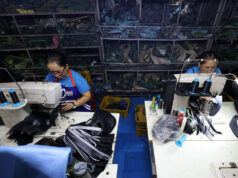Pinoy food beyond the table

THE CULMINATING talk of Filipino Food Month, titled “The Endless Possibilities of Filipino Cuisine,” took the discussion beyond the table and into the fields of tourism and education.
The talk, held over Facebook Live on April 30, brought together the Head of the National Commission of Culture and the Arts’ (NCCA) Committee on Music Prof. Felipe de Leon, Jr., sustainable tourism advocate and co-chair of the Philippine Coffee Board Pacita Juan, and Agricultural Counselor for the Philippine Embassy in Beijing Ana Abejuela.
Mr. De Leon made a case for the continued celebration of Filipino Food Month despite the pandemic. “Ang pinakamalapit sa puso ng mga Pilipino, bukod sa kanyang wika, ay relihiyon; pangatlo ang pagkain. Maski gaano katagal na sa ibang bansa ang isang Pilipino, hindi pa rin niya makakalimutan ang kanyang relihiyon, wika, at panglasa. Talagang hinahanap pa rin niya ang pagkain natin (The thing closest to a Filipino’s heart, aside from their language, is their religion; third is food. No matter how long one stays in another country, they do not forget their religion, language, and tastes. They still really look for our food),” he said. “Para sa akin, importante na mapag-aralan ang pagkain, para lalong maintindihan ang ating kultura (For me, it is important to study food, to better understand our culture).”
Ms. Abejuela, meanwhile, takes a stab at its necessity for purposes of the economy. “When that awareness is awakened, it starts. You like it. If you like it, you buy it, or you eat it in a restaurant. You cook it at home. At the end of the day, it creates economic activity.”
According to Mr. De Leon, during NCCA’s Heritage Month (celebrated every May), their office collects 150 recipes from all over the country, noting that the most familiar are those found in the lowlands. By his count, there are at least 131 languages spoken in the Philippines — each one corresponding to a unique group, each with their own recipes. “Kapag nakilala natin ang kani-kanilang luto — ay naku! — ang laki-laking industriya niyan (When we become familiar with each of their cuisines — my goodness! — what a huge industry it could be).”
“What we need to focus on is the use of local ingredients,” said Ms. Juan in a mix of English and Filipino. “It is timely for us to discover using our local ingredients,” she said, citing difficulties in the shipping and logistics industry due to the pandemic; thus delaying the arrival of imported goods. “We need to ask, ‘Why have we been given this kind of food?’ We need to re-appreciate the local food for those at home, for those who cook — because the consumer is always a co-producer. If it isn’t eaten, it won’t be grown.”
Speaking of producing, Ms. Juan also pointed out how Korean soft power via K-drama has played a role in promoting that country’s cuisine (and by extension, its culture). She urges Filipino entertainment to do the same to inject “more cultural nuance into the script, but the viewer will appreciate it because it’s contextual.”
On a related note, Ms. Abejuela thinks that instilling familiarity with our cuisine (and therefore a love for it) should start at a young age, suggesting the expansion of Home Economics programs in schools. Based on her own experience, “We usually cooked, before, local dishes with the ingredients available, and the ingredients that we have planted,” she said. “It starts with the young. If children are aware of how beautiful and how delicious our dishes are, they will look for them,” she said in a mixture of English and Filipino.
Promotion of Filipino cuisine had been brought up due to the discussion of the more pervasive influence of other Asian cuisines on the world stage: everybody knows what sushi, pad thai, or bulgogi is; but it takes some work to introduce sisig or adobo. “The show-window of a country is when tourism goes up,” said Ms. Juan. “We need that tipping point in the number of tourists who visit us,” she said. “The availability of access to a country’s culture brings the food with it.” She still hopes though, that with the number of Filipinos abroad, our cuisine could make an impression on the world’s palate.
Mr. De Leon agrees. “Ang access, nasaan (Where is the access)?
“When you go to a place, it’s so hard to find Filipino food. Filipinos have to appreciate their own culinary fare [first],” he said in a mix of English and Filipino. “How can we convince other people about the story of our own food?” — J.L. Garcia



